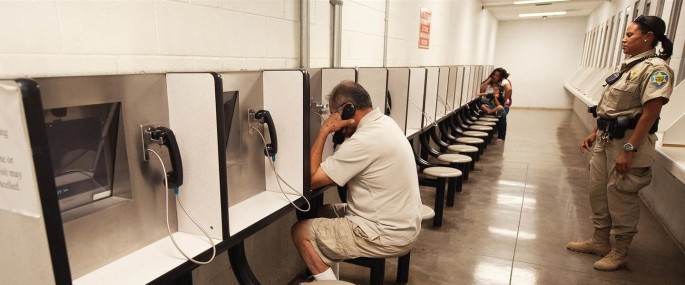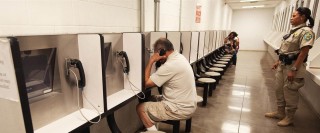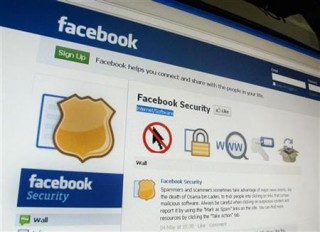As Jail Visits Go High-Tech, Isolation Grows
The following is an excerpt from NBC News.
Twice a week, Ashika Coleman-Carter drives out to the Travis County Correctional Complex, in Texas, to visit her husband. But when she sits down to say hello, she doesn’t look at him through the traditional shatter-proof glass. Instead, she sees Keith’s face on a video screen.
“It just seems so impersonal,” she said. “The old visits, even though you couldn’t touch behind the glass, at least you could go into an actual visiting room and see someone’s face. Now you can’t get close to the person at all.”
More than 500 prisons and jails across 43 states and Washington, D.C., now use video systems for visitation, according to a recent national survey from the Prison Policy Initiative, or PPI, a non-profit advocacy group.
The growth speaks to the tension at the heart of criminal justice today — how state and local governments can rein in costs while rehabilitating prisoners, and without punishing their families. The balance struck may shape the future of visitation in America’s massive criminal justice system.
The future of video visitation in highlights the ongoing tension between the push to cut the cost correctional facilities, and the effort to reduce the number of people we lock within them.
Correctional facilities and companies say video systems reduce contraband, expand visiting hours and save on staffing costs because inmates can talk from their cell pods rather than having to be transported to a visiting room. “Visitation going to video solves a lot of problems,” said Dave Henion, of GTL, formerly known as Global Tel Link, one of the largest providers of the systems.
Push for profit?
Advocates and families say the end of in-persons visits stems from a harmful push for profit that isolates prisoners and strains already-stretched family budgets.
“Incarceration has an effect on more people than those who are incarcerated–it affects families,” said Bernadette Rabuy, PPI’s policy and communications associate. “We shouldn’t be punishing families trying to stay in contact with their loved ones.”
“Ideally in concert with in-person visitation,” video visitation has the potential to be a benefit both facilities and families, a recent study by the Department of Justice found. State prisons have typically used remote visitation in concert with contact visits, but PPI found 74 percent of jails that implemented the technology subsequently banned in-person visitation.
Most video systems have two prongs. In the jails, visitors like Coleman-Carter sit down in front of a terminal and visit with inmates who sit at a terminal inside their cell pod. Most video systems now also allow for Skype-like visitation, where family can sign on and speak with loved ones from home for a fee, generally between $5 and $20 for a 20-minute visit. Critics of the systems say jails have gone to video-only visitation to encourage the fee-based home visits. But the money and technology limitations have made some families slow to choose that option.
Coleman-Carter, whose husband was sentenced to about 45 days for “resisting search,” sees the potential in remote visiting — less travel, shorter waits, easier scheduling. “If you had the proper Internet services and stuff, I would recommend doing it at home,” she said.
For families of those incarcerated, that can be a big if.
Coleman-Carter, 34, doesn’t have high-speed Internet at home. She tried using a hotspot on her phone once, but it didn’t work well. Then there’s the cost. Securus Technologies, another industry leader, which runs Travis County’s video system, charges $20 for a 20 minute remote session. She said that’s a lot to pay for a visit that, even on jail grounds, is often interrupted by static and buffering that eats away at precious minutes. “They won’t give you that time back,” she said. So rather than spend $1 a minute, she drives down to the jail where visitation is still free.
Complaints about the systems often focus on details. The arrangement of cameras prevents eye contact. Slow connections can interrupt audio and video. Because the terminals are set up within jail common areas, the visits can be interrupted, or overheard, by others nearby…




